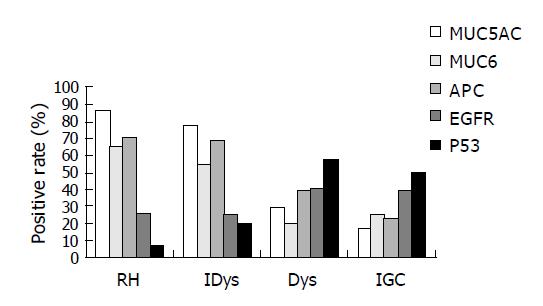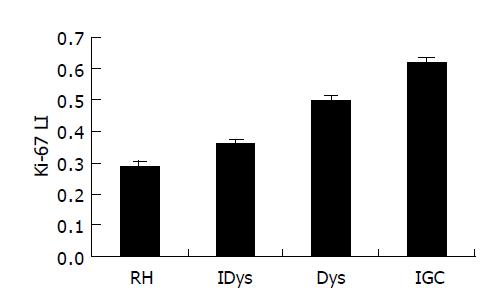Copyright
©2005 Baishideng Publishing Group Inc.
World J Gastroenterol. Jun 21, 2005; 11(23): 3595-3600
Published online Jun 21, 2005. doi: 10.3748/wjg.v11.i23.3595
Published online Jun 21, 2005. doi: 10.3748/wjg.v11.i23.3595
Figure 1 MUC5AC, MUC6, APC, EGFR, and p53 expressions in different gastric lesions.
Figure 2 A: MUC5AC immunostaining cells in one representative Dys specimen (standard Envision, peroxidase method ×100); B: MUC6 immunostaining cells in one representative Dys specimen (standard Envision, peroxidase method ×100); C: p53 immunostaining cells in one representative Dys specimen (standard Envision, peroxidase method ×100); D: Ki-67 immunostaining cells in one representative Dys specimen (standard Envision, peroxidase method ×100).
Figure 3 Ki-67 LI in different gastric lesions.
Figure 4 A: RH.
The general architecture of the mucosa is well preserved. The foveolae are tortuous. Hyperplastic epithelial alterations become progressively less prominent and gradually disappear from the hyperplastic mucosa to the adjacent normal areas. Besides, we can see inflammatory infiltrate, edema, reflecting the underlying cause of the hyperproliferative state (HE, ×100); B: IDys. In the context of an atrophic gastritis, the intestinalized glands show back-to-back architecture. But the structural and cellular alterations tend to decrease from the bottom to the most superficial mucosal layers. This “gradient of maturation” may be helpful in distinguishing the true noninvasive neoplastic (HE, ×100); C: LGD. Low-grade disorganized architecture consists of metaplastic glandular structures. Most of the glandular cells show mucus depletion. Nuclei are elongated (sometime with cigar-like appearance) and irregular in size. They are most frequently located at the basal pole and show slight pseudostratification. Atypical (rounded or cigar-like) nuclei are also seen at the surface epithelial layer. Both the architectural abnormality and the cytohistologic alterations are consistent with a noninvasive neoplastic lesion (i.e., low-grade Dys) (HE, ×200).
- Citation: Dong B, Xie YQ, Chen K, Wang T, Tang W, You WC, Li JY. Differences in biological features of gastric dysplasia, indefinite dysplasia, reactive hyperplasia and discriminant analysis of these lesions. World J Gastroenterol 2005; 11(23): 3595-3600
- URL: https://www.wjgnet.com/1007-9327/full/v11/i23/3595.htm
- DOI: https://dx.doi.org/10.3748/wjg.v11.i23.3595












